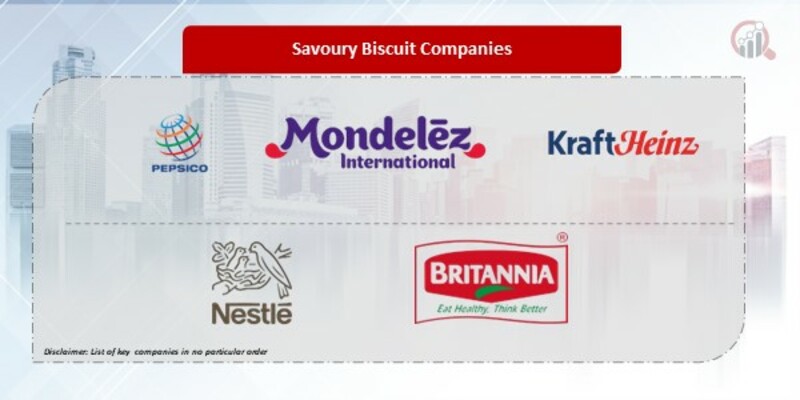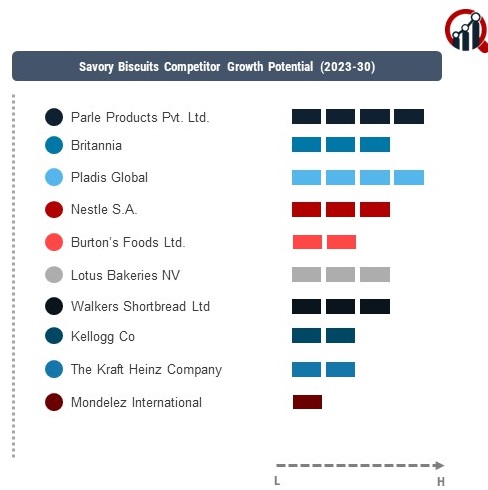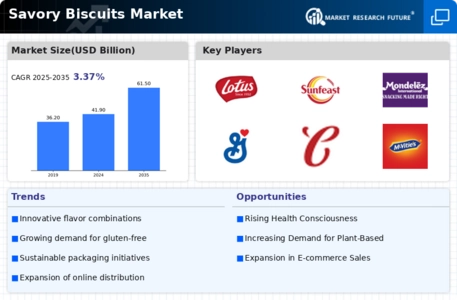Top Industry Leaders in the Savoury Biscuit Market

The competitive landscape of the savoury biscuit market is marked by intense rivalry among key players, each vying for a larger slice of the market share. As of 2023, the market is witnessing strategic maneuvers and dynamic shifts driven by changing consumer preferences and economic conditions.
Key players in the savoury biscuit sector include global giants such as
- ITC Limited (India)
- Kambly SA (Switzerland)
- Mondelez International (US)
- PepsiCo (US)
- The Kraft Heinz Company (US)
- Annie's Homegrown, Inc. (US)
- Parle Products Pvt. Ltd. (India)
- Patanjali Ayurved (India)
- Britannia (India)
- Kellogg Co (US)
- pladis global (UK)
Strategies Adopted:
The strategies adopted by these key players vary, but a common thread lies in the emphasis on product innovation and diversification. Companies are investing heavily in research and development to introduce new flavours, healthier alternatives, and packaging innovations to capture a wider consumer base. Additionally, strategic partnerships and collaborations with retail chains and supermarkets are being leveraged to enhance product visibility and availability.
Market Share Analysis Factors:
Market share analysis is influenced by various factors, with product quality, pricing strategies, and brand image playing pivotal roles. Established brands benefit from consumer trust and loyalty, but newer entrants can disrupt the market with competitive pricing and innovative offerings. For market leaders, maintaining and expanding their distribution channels remains crucial, ensuring that their products are easily accessible to consumers.
New & Emerging Companies:
In terms of new and emerging companies, the savoury biscuit market has witnessed the entry of several startups and smaller players attempting to carve a niche for themselves. These companies often focus on unique selling propositions, such as organic ingredients, gluten-free options, or ethnic flavours, to differentiate themselves in a crowded market. While these entrants may face challenges in terms of distribution and brand recognition, their agility allows for quicker adaptation to changing consumer preferences.
Industry Trends:
Recent industry news suggests a heightened focus on sustainability practices among key players. With an increasing awareness of environmental concerns, companies are incorporating eco-friendly packaging materials and sustainable sourcing of ingredients. This shift not only aligns with consumer values but also helps in building a positive brand image.
Current company investment trends reveal a notable uptick in digital marketing strategies. With the proliferation of e-commerce platforms and the increasing influence of social media, companies are diverting significant resources towards online advertising, influencer collaborations, and e-commerce partnerships. This shift is reflective of the changing consumer shopping habits and the need for a robust online presence.
Competitive Scenario:
The overall competitive scenario in the savoury biscuit market is dynamic and characterized by a constant push for innovation and differentiation. Companies are investing in market research to understand evolving consumer preferences, thereby enabling them to tailor their product offerings accordingly. The battle for shelf space in retail outlets continues to be fierce, with companies deploying various promotional activities and attractive packaging to grab consumer attention.
Recent Development
Significant developments have shaped the competitive landscape of the savoury biscuit market. Notably, there has been a wave of mergers and acquisitions, with larger companies strategically acquiring smaller players to strengthen their product portfolios and expand market reach. This trend is indicative of the industry's consolidation phase, as companies seek synergies to enhance their competitive positions.
Additionally, the ongoing global supply chain challenges have forced companies to reassess their sourcing strategies and production processes. Key players are investing in building resilient supply chains to mitigate the impact of disruptions, ensuring a steady flow of raw materials and finished products. This adaptability has become a key factor in maintaining a competitive edge in a volatile business environment.


